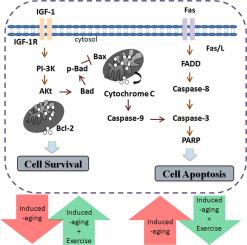Journal of Advanced Research ( IF 11.4 ) Pub Date : 2020-06-20 , DOI: 10.1016/j.jare.2020.06.015 Ing-Shiow Lay , Wei-Wen Kuo , Marthandam Asokan Shibu , Tsung-Jung Ho , Shiu-Min Cheng , Cecilia Hsuan Day , Bo Ban , Shulin Wang , Qiaowen Li , Chih-Yang Huang

|
Introduction
Insulin-like growth factor-I receptor (IGF1R) mediated survival signaling is a crucial mechanism for cellular endurance and a potential indicator of recuperation in deteriorating hearts.
Objective
This study evaluates the impact of long-term exercise training in enhancing cardiac survival mechanism in D-galactose-induced toxicity associated aging rats.
Methods
Forty-eight male SD-rats were segregated into 4 groups (n=9) and were named as control, exercise training groups, aging group and aging group with exercise training. Aging was induced by intraperitoneal (IP) D-galactose (150 mL/kg) injection for 8 weeks and for exercise training, the rats were left to swim in warm water for 60 min every day and 5 times/week. Western blotting of proteins from the left ventricles was performed to identify the modulations in the survival signaling. Tissue sections were analyzed to determine the extent of fibrosis and apoptosis.
Results
Western-blot analysis performed on the excised left ventricles (LV) showed that proteins of the cardiac survival pathway including IGF1R and Akt and the pro-survival Bcl-2 showed significant decrease in the aging group, whereas the levels were restored in the aging rats subjected to exercise training. In addition, aging groups showed increased interstitial space and collagen accumulation. Further, TUNEL assay showed higher number of apoptotic cells in the LV of aging group, which was correlated with increase in the proteins involved in FAS-FADD-dependent apoptosis. However, these aging associated effects were ameliorated upon exercise training in the D-galactose-induced aging rats that showed elevated IGF1R/Akt signaling.
Conclusion
The results suggest that IGFIR survival signaling cascadeis elevated in following long-term exercise training and thereby provide cardio-protective benefits in D-galactose induced aging rats.
中文翻译:

运动训练恢复 d-半乳糖诱导衰老大鼠的 IGFIR 存活信号以抑制心脏细胞凋亡
介绍
胰岛素样生长因子-I 受体 (IGF1R) 介导的生存信号传导是细胞耐力的关键机制,也是恶化心脏恢复的潜在指标。
客观的
本研究评估了长期运动训练对增强 D-半乳糖诱导的毒性相关衰老大鼠心脏存活机制的影响。
方法
将48只雄性SD大鼠分为4组(n=9),分别命名为对照组、运动训练组、衰老组和运动训练衰老组。通过腹膜内(IP)D-半乳糖(150 mL / kg)注射8周诱导衰老,对于运动训练,大鼠每天在温水中游泳60分钟,每周5次。对来自左心室的蛋白质进行蛋白质印迹以确定存活信号中的调节。分析组织切片以确定纤维化和细胞凋亡的程度。
结果
对切除的左心室 (LV) 进行的蛋白质印迹分析显示,包括 IGF1R 和 Akt 在内的心脏存活通路蛋白和促存活 Bcl-2 在衰老组中显示出显着降低,而在衰老组中水平恢复受过运动训练。此外,老化组显示出增加的间质空间和胶原蛋白积累。此外,TUNEL 测定显示衰老组 LV 中凋亡细胞数量增加,这与参与 FAS-FADD 依赖性细胞凋亡的蛋白质增加有关。然而,这些与衰老相关的影响在 D-半乳糖诱导的衰老大鼠的运动训练中得到改善,这些大鼠显示出升高的 IGF1R/Akt 信号传导。
结论
结果表明,IGFIR 生存信号级联在长期运动训练后升高,从而为 D-半乳糖诱导的衰老大鼠提供心脏保护作用。











































 京公网安备 11010802027423号
京公网安备 11010802027423号